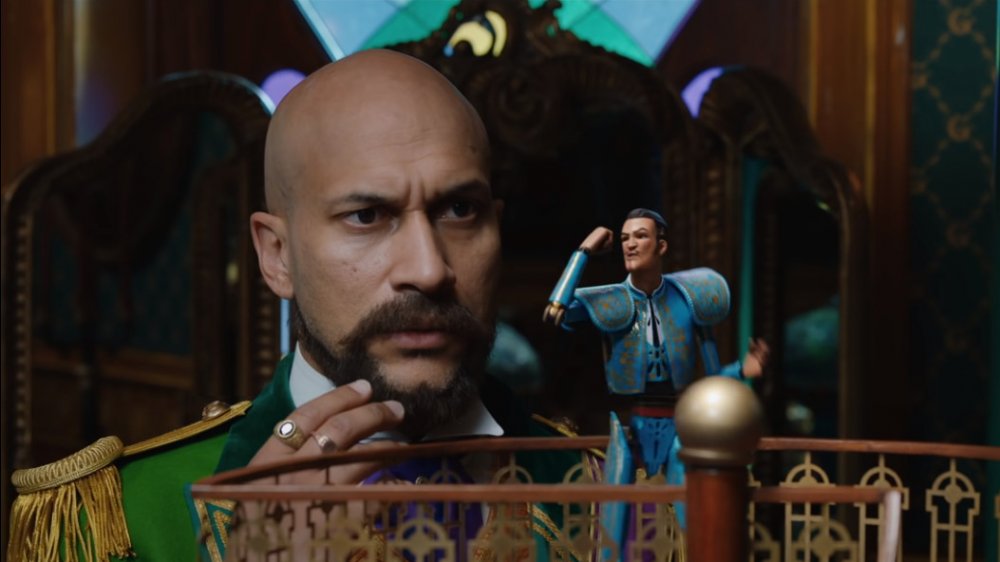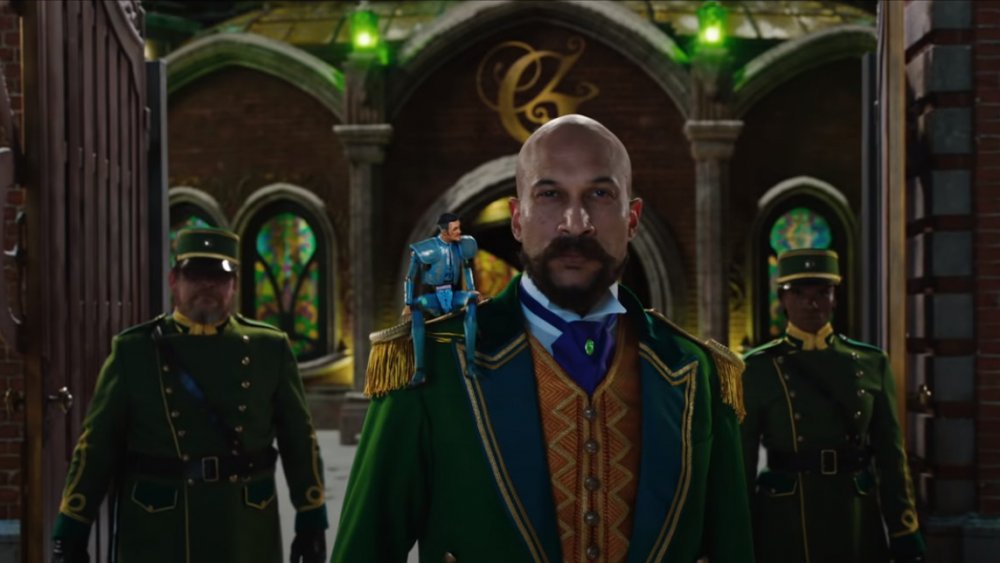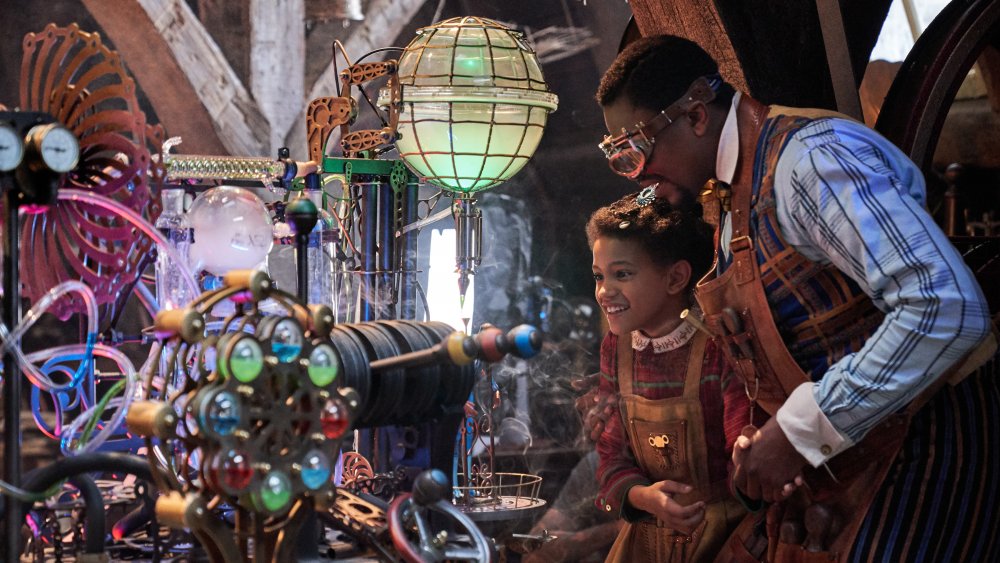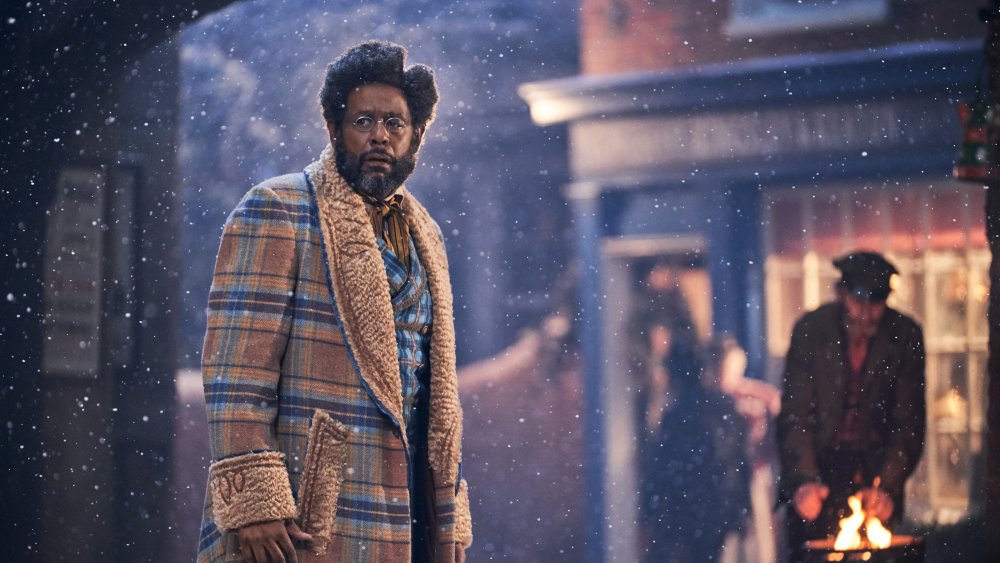The One Jingle Jangle Scene That Makes Us Love Keegan-Michael Key Even More
This content was paid for by Netflix and created by Looper.
Jingle Jangle: A Christmas Journey features a truly all-star cast of performers stepping into a magical world of lavish costumes, musical numbers, and a little holiday magic. The film includes standout performances from Forest Whitaker, Ricky Martin, Phylicia Rashad, Anika Noni Rose, and of course the young lead Madalen Mills. But even among all of them, Keegan-Michael Key manages to stand out.
Key's reputation as a comedic performer willing to put tremendous physicality and commitment into every role is well-known, and he certainly brings that to Jingle Jangle. But as the thieving toymaker Gustafson, he gets to do something that he hasn't been able to do in many of his best-known projects: Play a villain. Because the film is a family friendly affair, he doesn't do anything particularly nasty, but watching Key chart the course of a bad guy who just might learn a lesson or two through one magical Christmas is a treat. That's because it reminds us just how much we love the way he throws himself into every role.
Key pulls off several scene-stealing moments throughout Jingle Jangle, but among all of them, one in particular stands out and makes us love him even more. Just moments after his character's flashy, musical introduction, Key has a dramatic heart-to-heart with another key player in the story that shows us just how far he's willing to go to get what he wants.
It's how it showcases his range
We first meet the older version of Key's character, the toymaker Gustafson, through a raucous musical number that ends when his new invention, the Whirly Twirly, backfires on a crowd of onlookers. Until that moment, Gustafson is upbeat, happy, full of swagger, and never betrays even a hint of self-doubt in terms of the man he's become.
Then, in our key scene, Gustafson retreats to his office, where the film reveals that the Matador (Ricky Martin) who talked him into stealing Jeronicus Jangle's inventions all those years before is still very much the power behind the throne. In the scene that follows, Gustafson vents his frustration over never being able to get the Whirly Twirly to work. Key has to shift his acting talents from being the showman Gustafson tries to be in front of crowds of customers and turn into the scared, insecure, ultimately submissive toymaker who's terrified that he'll never be more than a thief. It's a grown man talking to a little talking action figure, but it's a scene rich with drama.
And yet, even with the dramatic tension present in the scene, Key manages to insert some of his comedic skills into the moment. The way he points at the wall and highlights his many "Toymaker of the Year" plaques is reminiscent of some of his best characters on Key & Peele, using his nervous energy to get laughs. He manages to be the total acting package in a single moment.
It's how cartoonish he's willing to get
Jingle Jangle is a film that, in the spirit of many of the great Christmas movies, mixes a lot of genuine human concerns with whimsical, often flat-out magical concepts, and that's very evident in the way that Key portrays Gustafson. By the time we meet Key's version of the character, years after the film's earliest scenes, the toymaker has an almost Willy Wonka-like energy, if Willy Wonka were willing to flaunt his gifts to the world a little more often. He's stylish, he's a showman, and — in public at least — he's willing to act like the king of the world.
This near-cartoonish stylings of his public appearances are offset by the reality of Gustafson's world: He's a toymaker who's only successful because he stole someone else's work, and he feels like a constant fraud in need of some affirmation. The cartoonish side of him is a performance, and yet the serious side of him has to contend with a talking action figure as his key confidante. That's cartoonish in and of itself, which means that Key has to play both sides of Gustafson's personality in a way that's both broad and precise — and he somehow manages to do both while making it look easy.
It's how it compares to another key scene
Jingle Jangle is, in some ways, about the parallel stories of two toymakers and their intertwining and shifting fortunes over a period of many years. And that presents some interesting acting challenges for Key. As Gustafson, he is clearly set up as the villain, but in many ways he's not really that different from the man whose life and reputation he ruined, Jeronicus Jangle. When we meet Jeronicus later on, he's a broken man, tinkering around in a darkened shop, having lost his family and his faith in himself along with his toy ideas.
What we perhaps don't realize at first is that Gustafson is, for all his wealth and acclaim, actually going through something similar. There's a real darkness to Key's first scene opposite the Matador, because it becomes clear over the course of that scene that Gustafson also feels like he's losing everything, including any confidence he's managed to build up over the years. If Gustafson managed to "win" by stealing Jangle's book of ideas all those years ago, it's now clear that he's on course to lose just as badly if he can't do something. Of course, the difference is that, unlike Jeronicus, he's willing to sacrifice his soul in the process, something Key plays with real energy and vulnerability.
It's how it sets up the arc of the film
The first scenes with Key's version of Gustafson and the Matador establishes many things that help inform the overall arc of Jingle Jangle as a film, and as a personal journey for Gustafson. The scene is so compelling because Key basically has to find a way to play all these disparate elements all at once. He has to be silly, serious, emotional, outrageous, and vulnerable all in the course of one scene, because this moment becomes the driving force of everything that will come after, setting up the parallel stories of the two toymakers.
On one side, you have Jeronicus, a man who seems to have lost his mojo since the day Gustafson stole his ideas. He learns over the course of the film that he needs to let other people into his life again if he wants to have any hope of happiness. On the other, you have Gustafson, who's been tricked by the Matador into believing that he will one day achieve fulfillment all by himself if he just keeps taking from others. In the end, Gustafson learns that all he really needed in the first place was a little faith in another human being, because Jeronicus had always planned to help him. Both men learn, in their own ways, that closing themselves off is not the answer, and that they need to trust others if they're going to win. The tragedy of Gustafson is that he learns it too late.



